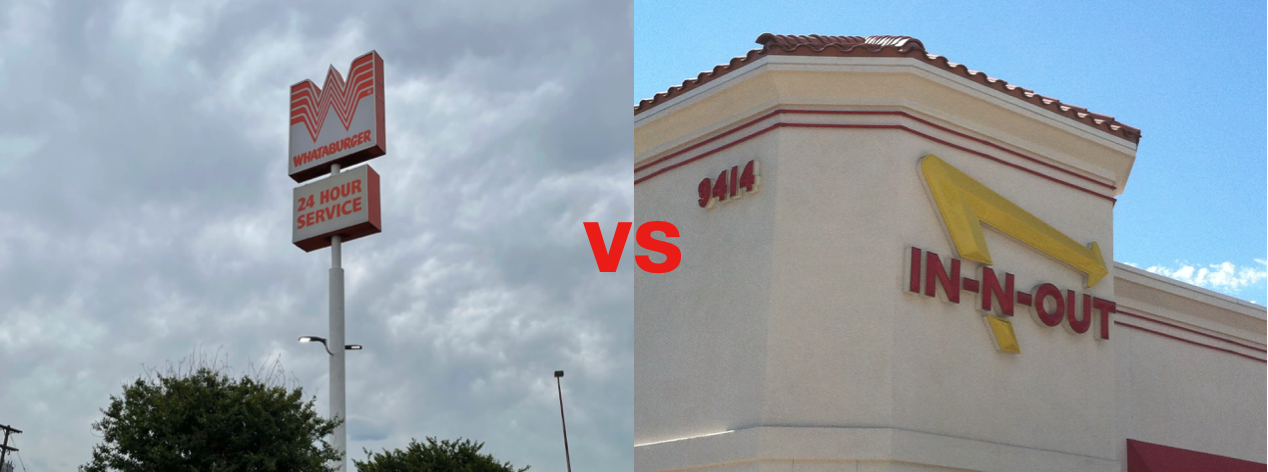Which fast food burger chain is better: Whataburger or In-N-Out?
The debate rages. Texans loudly proclaim their allegiance to Whataburger. Californians quickly tell you that In-N-Out is the best. Other states might feel caught in the middle.
So just for fun, I devised an objective test.
Let's forget polls run by food magazines that are more about state pride than real quality. I compared Whataburger and In-N-Out head-to-head in by using Yelp reviews for comparable locations in Texas.
That's right, I gave Whataburger a huge home field advantage.
Home field advantage didn't matter. In-N-Out won by a landslide. It was absolute, total domination. Frankly, I was surprised that it wasn’t even close.
Before you send me an angry email, keep in mind this wasn't my subjective opinion. People in Texas consistently rate In-N-Out much higher than Whataburger on Yelp.
About the Whataburger vs. In-N-Out test
In-N-Out Burger is a relative newcomer to Texas. The fast food hamburger chain was founded in Southern California in 1948 by Harry Snyder. It wasn't until 2011 that In-N-Out opened it's first Texas location.
Today, there are 40 In-N-Out locations in Texas.
Whataburger, by contrast, has Texas roots. Harmon Dobson opened the first location in Corpus Cristi, Texas in 1950. There are 697 Whataburger locations in Texas today.
To make the test fair, I mapped out each In-N-Out location in Texas, identified the closest Whataburger, and then compared the Yelp reviews for the two locations.
This was fairly easy to do. In some cases, there’s a Whataburger in the same parking lot as an In-N-Out. In most other cases, the nearest Whataburger is just down the street.
Consumers craving a fast food burger in these markets could easily choose between the two chains. The Yelp reviews tell us which they like better.
How In-N-Out beat Whataburger in a landslide
The test used data from Yelp reviews to evaluate three key categories:
Overall rating
Enthusiasm (total number of reviews)
Consistency
In-N-Out won all three tests handily.
Overall Rating
I compared the Yelp reviews for each of the 40 In-N-Out locations in Texas to the nearest Whataburger. All 40 In-N-Out locations had a higher Yelp rating than it's closest Whataburger competitor.
Yep. In-N-Out pulled off a clean sweep of Whataburger in Texas.
There was a wide gap in average rating between the two chains when you compare In-N-Out with nearby Whataburger locations:
Enthusiasm
I used the total number of reviews for each location as a proxy for customer enthusiasm. The higher the number of reviews (regardless of rating), the more enthusiastic the customer the base.
It's not a perfect metric. For instance, it doesn't control for the length of time a location has been open. Since Whataburger has a 61 year head start on In-N-Out (1950 vs. 2011), Whataburger would seem to have the advantage here.
It didn't matter. A whopping 37 out of 40 In-N-Out locations had more Yelp reviews than the nearest Whataburger.
In-N-Out averaged more than twice as many Yelp reviews per location:
Consistency
This last measure is about the entire chain, rather than just one location. The hallmark of a great business is you can rely upon a consistently good experience no matter where you go.
This is where In-N-Out really crushed it.
Every In-N-Out in Texas enjoys either a 3.5 or 4.0 average Yelp rating. Meanwhile, the nearest Whataburger locations ranged from 1.5 to 3.0.
Why are Whataburger's reviews worse than In-N-Out?
A lot goes into a Yelp review. Food taste and quality are important factors, but those aren’t the only things that customers care about.
Negative reviews for both chains tend to focus on three issues:
Wait time
Order accuracy
Friendliness
Wait time is particularly interesting.
Both Whataburger and In-N-Out prepare your meal to order, so the wait will always be longer than if you go to a chain that sells pre-made burgers stored under a heat lamp.
Strangely, the average wait at an In-N-Out is typically much longer because In-N-Out is usually a lot more crowded. (At least according to my anecdotal observations and personal experience as a fan of both chains.)
So why does Whataburger get dinged more than In-N-Out?
Because wait time is just as much about perception as it is actual elapsed time. Given the right set of circumstances, wait time can feel dramatically longer.
Negative Whataburger reviews that mentioned wait time often called out that the restaurant didn't seem very crowded. This caused customers to wonder why they were waiting so long.
In-N-Out customers, on the other hand, can see the long line of customers in front of them. They expect to wait because the chain is so popular.
Part of Whataburger's challenge is consistency. Wait time, accuracy, and even friendliness seem to be highly variable at locations with low Yelp ratings.
One explanation might be that Whataburger is no longer a family-owned company like In-N-Out. It’s not even a Texas company anymore. In 2019, the company was purchased by BDT Capital Partners, a company based in Chicago.
Meanwhile, In-N-Out is built on consistency. I profiled the company in my book, Getting Service Right, and found it has stayed focused on its core mission of offering quality, cleanliness, and courtesy throughout its entire history. It's still family run, doesn't franchise, and exclusive sells burgers, fries, and drinks.











